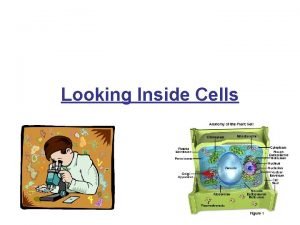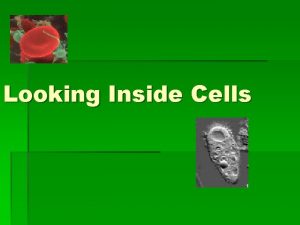Looking Inside Cells Teacher Imy Cajigas 7 th











- Slides: 11

Looking Inside Cells Teacher Imy Cajigas 7 th grade Life Science

Enter the cell • Cell Wall – is a rigid layer that surrounds the cells of plants and other organisms. • A plant’s cell wall protects and support the cell. • Cell Membrane- it forms the outside boundary to separate the cell from the environment. Controls what substances comes in and out of the cell.

Sail on to the nucleus • The nucleus is the control center of the cell that directs all of the cell’s activities. • The nuclear envelope protects the nucleus. • Chromatin are strands that contain genetic material. • Nucleolus- is where ribosomes are made (ribosomes are the organelles where proteins are produced).

Organelles in the Cytoplasm • The cytoplasm is a gel-like fluid that is constantly moving. Many organelles are found in the cytoplasm. • Mitochondria“powerhouse” produce most of the cell’s energy. • Endoplasmic Reticulumcarry proteins and other materials from one part of the cell to another. • Ribosomes- function as factories to produce proteins.

Organelles in the Cytoplasm • Golgi Body- Receive protein and other materials from the ER and send them to other parts of the cell. • Vacuole- Stores food, waste products and other materials. • Lysosomes- “cell’s clean up crew” small, round structures that contain chemicals that break down certain materials in the cell.

Cell Structure Lab

Onion Stained with Iodine Cell wall cytoplasm Nuclear envelope nucleolus chromatin http: //www. microscopy-uk. org. uk/mag/imgapr 06/09 -Eosine. jpg

Elodea Cells http: //carnegieinstitution. org/first_light_case/horn/lessons/images/chlorop. jpg

Cheek Cells Stained with Methyl Blue Nucleus Plasma Membrane Cytoplasm http: //faculty. kutztown. edu/friehauf/science_outreach/cheek_cells_005. jpg

Plant Versus Animal Cell • Note the cell wall present in both onion and elodea cells. • No such cell wall is visible in the animal cell. • All cells have visible nuclei and nucleoli, nuclear envelopes, and cytoplasm.

Specialized Cells • The cells are quite different from each other and are specialized to perform different functions. • Nerve cells are specialized to transmit information from one part of your body to another. • In many-celled organisms, cells are organized into tissues, organs, and organ systems.
 Looking inside cells answer key
Looking inside cells answer key Cell membrane
Cell membrane Looking out looking in summary
Looking out looking in summary Looking out looking in chapter 9
Looking out looking in chapter 9 Looking inside the computer system
Looking inside the computer system Plant and animal cell venn diagram
Plant and animal cell venn diagram Waters view with open mouth
Waters view with open mouth What cell type
What cell type Somatic vs germ cells
Somatic vs germ cells Prokaryotic cells vs eukaryotic cells
Prokaryotic cells vs eukaryotic cells Transport maximum
Transport maximum Staphylococcus aureus prokaryotic or eukaryotic
Staphylococcus aureus prokaryotic or eukaryotic





















